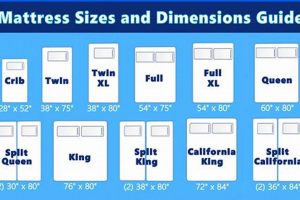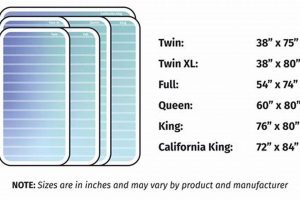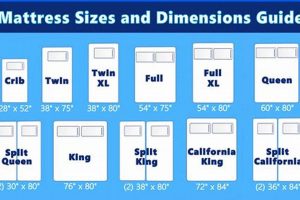The largest available sleeping surface, typically designated as a Wyoming King, Alaskan King, or Family Size, offers expansive dimensions exceeding standard mattress sizes. For instance, a Wyoming King measures 84 inches by 84 inches, providing substantial personal space for individuals or ample room for multiple occupants. These oversized options cater to specific needs where maximizing the sleeping area is paramount.
Expanded sleeping surfaces present distinct advantages. Individuals seeking unrestricted movement during sleep find them beneficial, as do couples desiring separation of space. Furthermore, families co-sleeping with children or pet owners sharing their beds often find these mattresses ideal for accommodating multiple sleepers comfortably. Historically, the emergence of these larger formats reflects a growing demand for customized sleep solutions tailored to evolving lifestyles and preferences.
The remainder of this article will explore the considerations involved in acquiring an extra-large sleeping platform, including room dimensions, available construction materials, and the practical implications for bedding and overall sleep quality. Furthermore, we will examine alternative solutions for maximizing sleep space when limitations prevent the use of such a substantial mattress.
Considerations for the Largest Mattress Dimensions
Selecting a sleep surface with maximum dimensions requires careful planning and evaluation. The subsequent guidelines address critical factors to consider prior to purchase.
Tip 1: Assess Room Dimensions Precisely: Accurate measurements of the intended bedroom are essential. Ensure adequate space for the mattress, allowing for peripheral movement and placement of other bedroom furniture. Restricting room dimensions can negate the advantages of an expansive sleep surface.
Tip 2: Evaluate Structural Support Capacity: Larger mattresses possess substantial weight. Confirm that the bed frame and underlying floor structure can adequately support the combined weight of the mattress and its occupants. Reinforcement may be required for older or weaker structures.
Tip 3: Budget for Specialized Bedding: Standard bedding sizes will be insufficient. Allocate resources for custom or specialized sheets, blankets, and comforters tailored to the mattress’s unique dimensions. Availability and cost should be factored into the overall budget.
Tip 4: Anticipate Difficulty in Transportation and Maneuvering: Due to their size and weight, moving these mattresses can be challenging. Plan for professional assistance or a sufficient number of individuals to ensure safe transport and installation. Consider doorway widths and staircase access.
Tip 5: Research Mattress Construction and Materials: Optimal support and comfort are crucial. Investigate different mattress types (e.g., memory foam, innerspring, hybrid) and material quality to ensure the chosen mattress provides adequate support and pressure relief across its entire surface area.
Tip 6: Consider the Impact on Room Aesthetics: A mattress with maximum dimensions dominates the room’s visual space. Evaluate its impact on the overall aesthetics and ensure it complements the existing decor. A disproportionately large mattress can make a room feel cramped.
Tip 7: Evaluate Long-Term Investment and Replacement: The lifespan of oversized mattresses should be carefully considered. Given their cost and potential difficulty in disposal, understanding the manufacturer’s warranty and potential replacement expenses is essential.
By carefully considering these factors, informed decisions can be made regarding the suitability and practicality of acquiring an expansive mattress. These considerations prevent unforeseen challenges and ensure the long-term enjoyment of the investment.
The following sections will delve into specific types of oversized mattresses and explore potential alternatives for those facing spatial constraints.
1. Maximum Surface Area
Maximum surface area, in the context of oversized mattresses, represents the total sleeping space available to occupants. This dimension is a primary differentiator among mattress sizes, influencing comfort, movement freedom, and overall sleep quality. It is a critical factor in the selection process when considering larger sleeping surfaces.
- Unrestricted Movement and Sleep Quality
Increased surface area provides enhanced freedom of movement during sleep. Occupants are less likely to disturb each other, leading to improved sleep quality for both individuals. For example, an Alaskan King size mattress offers substantial space, allowing individuals to change positions without encroaching on their partner’s area, a significant advantage for restless sleepers.
- Accommodating Multiple Occupants
Maximum surface area facilitates comfortable co-sleeping arrangements. Families with young children or pet owners sharing the bed benefit from the expanded dimensions, minimizing crowding and maximizing individual comfort. Consider a Family Size mattress, which is specifically designed to accommodate multiple sleepers without compromising personal space.
- Enhanced Comfort for Larger Individuals
Taller or larger individuals require greater sleeping space for optimal comfort. A larger mattress prevents limbs from hanging off the edge, providing consistent support and promoting proper spinal alignment. For instance, a California King provides extra length compared to a standard King, catering to taller individuals’ needs.
- Spatial Requirements and Room Compatibility
While maximum surface area offers benefits, it necessitates careful consideration of room dimensions. Larger mattresses require adequate floor space, impacting room layout and furniture arrangement. A Wyoming King, for example, demands a substantial room to avoid overcrowding, highlighting the importance of measuring available space prior to purchase.
The interplay between these facets underscores the significance of maximum surface area in the selection of oversized mattresses. The benefits of increased sleeping space must be weighed against practical considerations such as room size and cost. Informed decision-making ensures the chosen mattress aligns with individual needs and spatial constraints.
2. Enhanced Sleep Freedom
The correlation between enhanced sleep freedom and maximum mattress dimensions is direct and consequential. A larger sleeping surface inherently provides greater physical space, which translates to less restricted movement during sleep. This freedom mitigates disturbances, especially for co-sleepers, as individuals can change position without encroaching upon another’s personal space. The effect is a reduction in sleep interruptions and an improvement in overall sleep quality. The importance of this freedom is particularly evident for restless sleepers or individuals with conditions that require frequent position changes.
Consider, for instance, a couple where one partner is a light sleeper. A standard-sized mattress may lead to frequent awakenings due to the other partner’s movements. However, utilizing a larger surface significantly reduces the likelihood of such disturbances. Another example is individuals experiencing back pain, who often need to shift positions throughout the night to maintain comfort. A constrained sleeping area limits their ability to do so effectively, leading to discomfort and disrupted sleep. The practical significance lies in the improved rest and rejuvenation afforded by uninhibited movement, which is a key element in achieving restorative sleep.
In summary, the acquisition of a mattress with maximum dimensions is a strategic investment in sleep quality for those prioritizing unrestricted movement. While factors such as room size and cost require consideration, the enhanced sleep freedom offered by these mattresses presents a tangible benefit. Understanding this connection is crucial for making informed decisions regarding sleep solutions and optimizing rest for individuals and co-sleepers alike. This understanding aids in addressing challenges related to sleep disturbances, solidifying the link between spacious sleep surfaces and improved well-being.
3. Spacial Accommodation Challenges
The acquisition of a mattress with maximum dimensions presents notable spatial accommodation challenges. These challenges extend beyond mere room dimensions, impacting furniture arrangement, accessibility, and overall room functionality. Addressing these issues proactively is crucial to ensure the practicality and usability of the oversized sleeping surface.
- Room Dimensions and Layout Constraints
The primary challenge involves the suitability of the room’s dimensions. Mattresses exceeding standard sizes demand significant floor space, potentially restricting movement and limiting furniture placement. For example, a Wyoming King mattress requires a room size that may render dressers or nightstands impractical. Such constraints necessitate a reevaluation of the room’s layout and potential downsizing of existing furniture.
- Accessibility and Maneuverability
Transporting and maneuvering a mattress of maximum dimensions can be difficult, particularly in spaces with narrow hallways or staircases. Standard doorways may prove inadequate, requiring specialized equipment or structural modifications for delivery and installation. The logistical complexities associated with moving such a substantial object must be considered prior to purchase.
- Impact on Aesthetics and Ambiance
A mattress with excessive dimensions can visually dominate a room, potentially creating a cramped or unbalanced aesthetic. A disproportionately large mattress may overwhelm the space, diminishing the overall ambiance and detracting from the room’s perceived comfort. Careful consideration of color schemes, furniture styles, and complementary decor is essential to mitigate this effect.
- Storage and Organizational Considerations
The reduction in available floor space due to a mattress of maximum dimensions can affect storage and organizational capabilities. Limited room for dressers or storage containers may necessitate alternative solutions, such as wall-mounted shelves or under-bed storage options. The impact on overall room functionality and storage efficiency must be evaluated.
Successfully integrating an oversized mattress into a bedroom environment requires meticulous planning and adaptation. The spatial accommodation challenges necessitate a holistic approach, considering not only the mattress dimensions but also the room’s structural limitations, aesthetic qualities, and functional requirements. By proactively addressing these challenges, individuals can optimize the use of space and create a comfortable and aesthetically pleasing sleeping environment.
4. Specialized Bedding Necessities
The acquisition of a mattress with maximum dimensions mandates the procurement of specialized bedding. Standard-sized sheets, blankets, and comforters are insufficient to adequately cover these expanded sleeping surfaces, necessitating custom or specifically designed bedding solutions. The availability, cost, and performance characteristics of these specialized items are crucial considerations when evaluating the practicality of oversized mattresses.
- Custom Sheet Dimensions
Standard sheet sets lack the dimensions required to properly fit oversized mattresses. Custom-sized sheets, with tailored depth and width, are essential for ensuring a secure and comfortable fit. Inadequate sheet dimensions can lead to slippage, discomfort, and reduced mattress protection. For instance, an Alaskan King mattress necessitates sheets with dimensions exceeding those of a standard King, requiring specialized manufacturing processes. The cost of custom sheets often exceeds that of standard options, adding to the overall expense of owning an oversized mattress.
- Oversized Comforters and Duvets
Comforters and duvets must adequately cover the entire surface area of the mattress to provide adequate warmth and aesthetic appeal. Standard-sized comforters will appear disproportionately small, leaving portions of the mattress exposed and detracting from the overall bedroom decor. Oversized comforters require significantly more material and labor to produce, resulting in higher prices. The availability of aesthetically pleasing and functional oversized comforters may be limited, requiring specialized sourcing or custom fabrication.
- Specialized Mattress Protectors
Mattress protectors are essential for safeguarding the mattress from spills, stains, and allergens. Oversized mattresses necessitate equally large protectors to provide complete coverage and maintain warranty compliance. Standard-sized protectors will leave portions of the mattress vulnerable, increasing the risk of damage and potentially voiding warranty claims. Specialized protectors designed for oversized mattresses may incorporate advanced features, such as waterproof membranes and hypoallergenic materials, contributing to increased cost.
- Pillow Accommodations
The expanded surface area of oversized mattresses often necessitates a greater number of pillows to provide adequate support and comfort. Standard pillow arrangements may appear sparse or inadequate, requiring additional pillows to fill the space and enhance the aesthetic appeal. Coordinating pillow sizes, styles, and materials to complement the oversized mattress and bedding can add to the overall expense and complexity of the bedding procurement process.
The specialized bedding necessities associated with mattresses of maximum dimensions represent a significant consideration. The added expense, limited availability, and unique performance requirements of these items must be factored into the decision-making process. Failure to address these necessities can compromise comfort, functionality, and the overall value proposition of the oversized mattress. A comprehensive understanding of these factors is essential for ensuring a satisfactory and cost-effective sleeping experience.
5. Structural Support Demands
The implementation of a mattress with maximum dimensions directly correlates with amplified structural support demands. The increased weight and surface area inherent in such mattresses necessitate a robust foundation capable of withstanding the sustained load. Inadequate support can result in mattress degradation, frame failure, and potential floor damage. The connection between the weight of a large mattress and the necessary support is causal; the former directly dictates the requirements of the latter. The importance of this consideration cannot be overstated, as it directly impacts the longevity of the mattress and the safety of the occupants. As an example, consider a Family Size mattress placed upon a bed frame designed for a Queen size. The excessive weight distributed across the undersized frame can lead to bowing, cracking, or complete collapse. Similarly, placing an Alaskan King mattress in a room with compromised subflooring can cause deflection and potential damage to the floor joists. Understanding this relationship is practically significant for preventing structural damage and ensuring a safe sleeping environment.
Further analysis reveals specific areas where structural support is critical. The bed frame must be constructed from materials capable of bearing the weight without deformation. Reinforcement may be required for frames constructed from lighter materials. The number and placement of support slats or crossbeams are also significant; insufficient support can cause the mattress to sag, leading to uneven weight distribution and premature wear. For instance, platform beds, while aesthetically appealing, must possess a solid or closely spaced slatted surface to adequately support a heavy mattress. The floor beneath the bed also plays a crucial role. Homes with older or weaker subflooring may require additional reinforcement to prevent sagging or deflection. This can involve reinforcing floor joists or adding additional support posts in the basement or crawl space. The practical application of this understanding involves assessing the existing structural capacity and implementing necessary upgrades before introducing an oversized mattress.
In conclusion, the structural support demands associated with mattresses of maximum dimensions represent a critical consideration that directly impacts safety, mattress longevity, and overall structural integrity. Failure to adequately address these demands can result in costly repairs and potential hazards. By carefully assessing the existing structural capacity and implementing necessary reinforcements, individuals can ensure a safe and supportive sleeping environment. This understanding links to the broader theme of responsible homeownership and the importance of prioritizing safety and structural integrity when making significant lifestyle changes, such as adopting a larger sleeping surface. The challenge lies in balancing aesthetic preferences with practical requirements, ensuring that the desire for an expansive sleeping surface does not compromise the safety and stability of the home.
Frequently Asked Questions About Mattresses of Maximum Dimension
The following section addresses common inquiries regarding the selection, implementation, and maintenance of the largest available mattresses. It aims to provide clarity and guidance for informed decision-making.
Question 1: What defines a mattress as belonging to the “biggest size mattress” category?
The designation encompasses mattresses exceeding standard King size dimensions. Typically, this includes Wyoming King, Alaskan King, and Family Size mattresses, characterized by substantial surface areas tailored to specific needs.
Question 2: What are the primary benefits of opting for a mattress of maximum dimensions?
Notable advantages include increased freedom of movement during sleep, minimized partner disturbance, accommodation of multiple occupants (families with children or pets), and enhanced comfort for larger individuals.
Question 3: What are the primary spatial considerations when contemplating a “biggest size mattress”?
Considerations involve accurate measurement of the intended room, assessment of accessibility for delivery, and evaluation of the impact on furniture placement and overall room aesthetics. Inadequate space negates the intended benefits.
Question 4: Does a “biggest size mattress” require specialized bedding?
Yes. Standard-sized sheets, comforters, and mattress protectors are inadequate. Custom or specifically designed oversized bedding is essential for proper fit, comfort, and maintenance of the mattress.
Question 5: What structural considerations must be addressed prior to acquiring a “biggest size mattress”?
The bed frame and underlying floor structure must possess sufficient load-bearing capacity to support the combined weight of the mattress and its occupants. Reinforcement may be necessary, particularly in older structures.
Question 6: Are there alternative solutions for maximizing sleep space if a “biggest size mattress” is impractical?
Alternatives include utilizing a standard King-sized mattress with strategically placed bed extenders or exploring adjustable bed frames that optimize space utilization without significantly increasing the mattress’s footprint.
In summary, the decision to acquire a mattress of maximum dimensions necessitates a careful evaluation of spatial constraints, structural requirements, and budgetary considerations. A comprehensive understanding of these factors ensures a satisfactory and sustainable sleep solution.
The subsequent section will explore the long-term financial implications associated with oversized mattresses.
Final Assessment
The preceding analysis has explored the multifaceted aspects of selecting and implementing mattresses of maximum dimension. Key considerations include spatial accommodation, structural support, specialized bedding requirements, and long-term financial implications. The benefits of enhanced sleep freedom and expanded surface area must be carefully weighed against the practical challenges associated with these oversized sleeping surfaces. Ultimately, the suitability of such a mattress is contingent upon individual needs, budgetary constraints, and the physical characteristics of the intended bedroom environment.
The acquisition of a sleeping surface from the “biggest size mattress” category represents a significant investment. Prudent decision-making requires a thorough assessment of both the potential benefits and the inherent limitations. Prospective purchasers are encouraged to conduct comprehensive research, consult with sleep specialists, and carefully evaluate their individual circumstances prior to committing to a mattress of this scale. The long-term satisfaction derived from such an investment depends on a meticulous and informed approach.



![Best Intex Queen Size Inflatable Mattress [Guide 2024] Organic & Natural Mattress Buyer’s Guide: Non-Toxic Sleep Solutions Best Intex Queen Size Inflatable Mattress [Guide 2024] | Organic & Natural Mattress Buyer’s Guide: Non-Toxic Sleep Solutions](https://mattressworldpa.com/wp-content/uploads/2025/07/th-2231-300x200.jpg)



